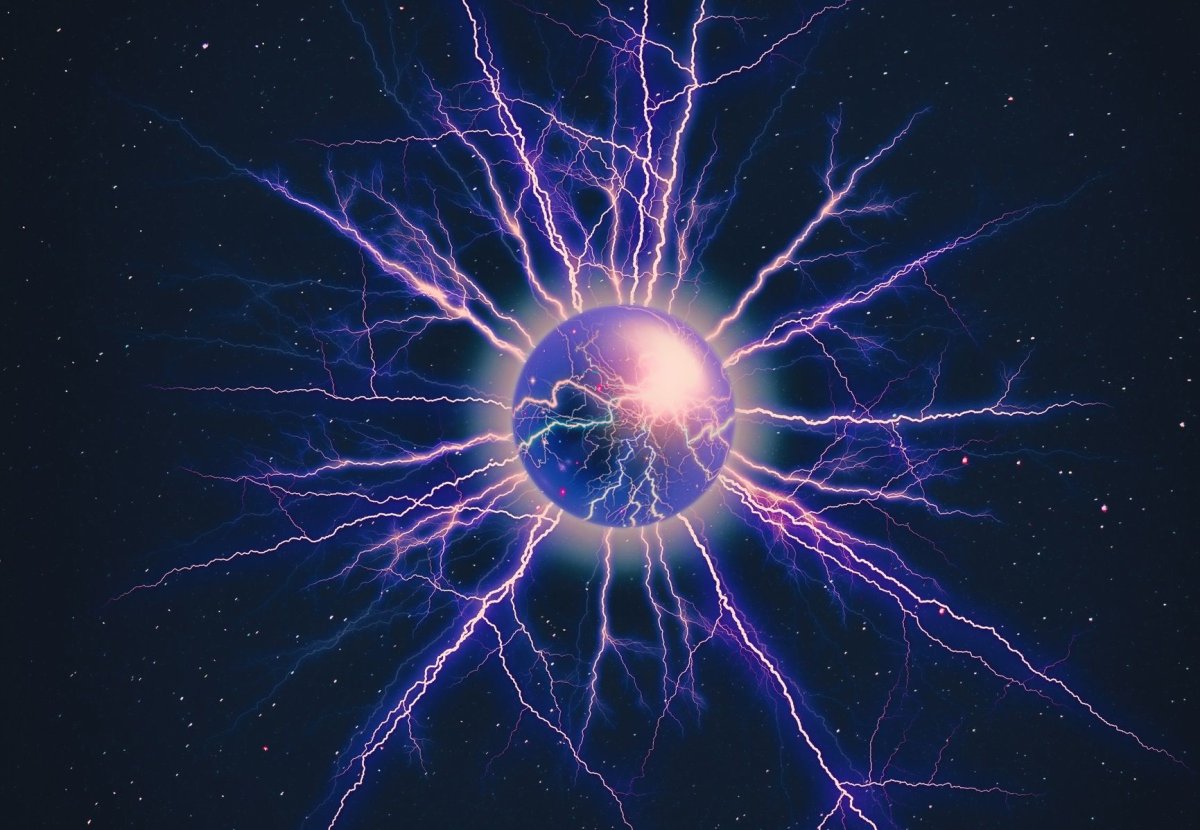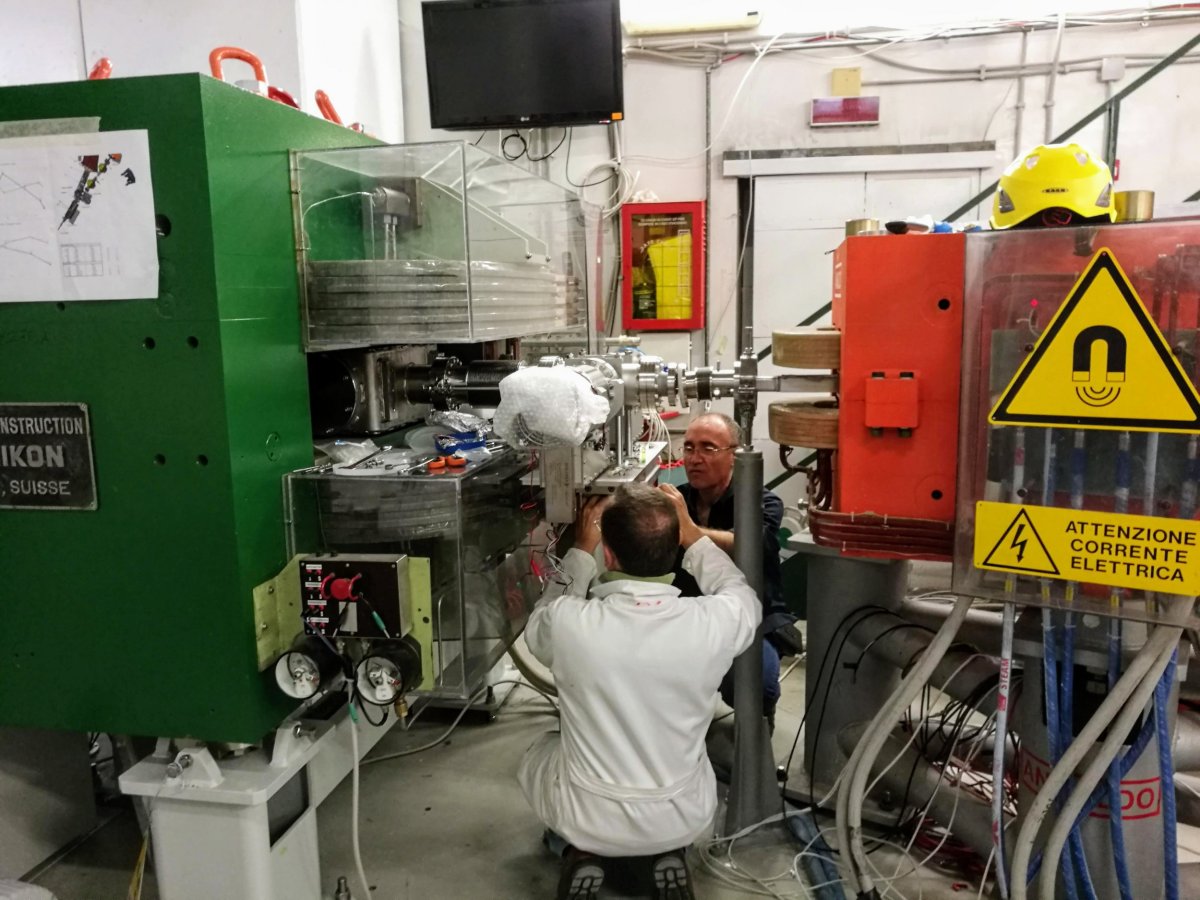
A team of physicists based at a lab near Rome, Italy, are about to switch on an experiment that could fundamentally alter our understanding of the universe.
Over the coming months, they'll be collecting data for a project known as PADME (short for "Positron Annihilation into Dark Matter Experiment") at a facility run by the National Institute of Nuclear Physics. The goal? To search for a hypothetical particle known as a "dark photon," which, if detected, would illuminate a mysterious "hidden" realm that is thought to make up the majority of the universe.
Currently, scientists cannot explain what more than 95 percent of the universe consists of. As a result, they have proposed the existence of hypothetical "dark" forms of energy and matter to help explain the vast gaps in our knowledge.
"We both know an awful lot about the dark universe and very little at the same time," Ethan Brown, a particle physicist from Rensselaer Polytechnic Institute, told Newsweek. "Cosmology measurements can tell us precisely how much dark matter and dark energy exist, and astronomical measurements can even tell us a lot how they behave. Yet we do not have any idea what theory underlies either of them."
Because we have been unable to directly observe the dark universe, or "dark sector," there are significant questions still to be resolved, such as whether dark matter represents a single new particle or an entire set, for example. Nevertheless, physicists think that they may be able to catch a glimpse of the dark sector by searching for dark photons. In a sense, these elusive particles may act as a kind of "portal" to this hidden realm.
"One of the possibilities is that dark matter is not standing in our world but in a separate place that we call the dark sector, which might contain several new particles—not only the dark photon, but a set of particles like we have in the Standard Model of particle physics," Mauro Raggi, a researcher from the Sapienza University of Rome, who is leading the PADME experiments, told Newsweek.
The Standard Model is our best description of the five percent or so of the universe that we can see. It outlines the four fundamental forces that govern nature and all the known elementary particles—those that are not composed of other particles.
"This dark sector is basically decoupled from the Standard Model sector," he said. In this scenario, dark matter particles "have no way of interacting with Standard Model particles," except if this interaction is mediated by what physicists refer to as a 'messenger' particle."
"Dark photons are one realization of the possible portals that connect the dark sector to our sector," he said. "That's the reason why we call it a 'messenger' particle because it's the only particle that may be able to interact with both our matter and dark matter."
Furthermore, dark photons could be seen to represent a mysterious new "fifth fundamental force of nature" that is entirely distinct from the four known forces outlined by the Standard Model.
Two of these forces are relatively familiar. The first—gravity—causes attraction between objects with mass or energy. It explains everything from how planets orbit around stars to why you don't go flying off the surface of the Earth as it spins. Meanwhile, the electromagnetic force is responsible for keeping electrons locked to the nuclei of atoms. This force plays a crucial role in determining the properties of most objects in daily life. The other two—the strong and weak nuclear forces—are not so well known, but they're just as crucial. The strong force holds atomic nuclei together, while the weak force is responsible for radioactive decay.
In the dark sector, however, there may be another fundamental force. In fact, it's possible that this realm contains multiple undescribed forces.
"At the particle physics level, we can think about forces between two objects as those objects exchanging particles," Adam Martin, an assistant professor of physics in the College of Science at the University of Notre Dame, told Newsweek. "So, a new particle in the zoo means there is another thing that can be exchanged and therefore a new 'force.'"
If this new fifth force is similar to the electromagnetic force that we have in the visible universe then its mediator is similar to the photon—the basic unit of all light (including visible light, X-rays, microwaves, and the rest of the electromagnetic spectrum). In this sense, dark photons are hypothetical partners, or 'cousins,' to photons in the observable universe.
"These 'cousins' are dark because if they exist, we cannot see them, similar to how dark matter is also dark because normal photons don't interact with it," Brown, said. "[Dark photons] exist theoretically to tie up some problems that we have with the Standard Model of particle physics, which works so well for everything that it describes but contains significant holes. This is because there's stuff that we know has to exist but we haven't found it yet. The dark photon could be one of these things."
In the more complex models of what the dark sector may look like, the dark photon could be responsible for the forces that act on the particles in this hidden realm of the universe, according to Brown.

"The dark photons could bounce off of these dark sector particles the way normal photons do with normal matter," he said. "If dark photons exist, and if dark matter is made up of dark sector particles, then the two would be related in this way. Those are a couple of big 'ifs', but that's why it's exciting to be able to make measurements to look for dark photons."
Part of the reason there is so much interest in dark photons, aside from their theoretical value, is that, unlike many other exotic hypothetical particles, they are predicted to have a helpful "signature" that scientists can look for using existing technology, negating the need to custom build new multi-billion dollar experiments.
It is predicted that dark photons will occasionally "bump" into ordinary matter and behave like an ordinary photon—and the signature of this process could be detected in experiments—although this may happen so rarely that no one has ever seen it before.
In the PADME experiments, Raggi and his team will use an accelerator to fire a beam of antimatter particles known as positrons—which as the name suggests, are positively charged—onto an extremely thin diamond wafer full of negatively charged electrons.
Normally, this process would annihilate both the positrons and the electrons, producing pure energy, which is then converted into Standard Model photons.
"But if you have a new dark force candidate, for example, if you have dark photons, then this might happen to produce not only a visible photon but a dark photon," Raggi said. "And that's what we are aiming to search for."
Because the dark photon cannot be observed directly, the researchers will use an extremely precise measuring instrument to compare the characteristics of the visible photon to those of the positron beam. Together, this information will enable them to infer whether a dark photon has been created and what its mass is.
Several other teams around the world are searching for dark photons using similar methods, but have come up empty-handed so far due to the difficulty involved in trying to detect them.
"The idea of dark photons has been around for a long time, so people certainly have looked," Martin said. "The problem with them is that there is a huge range of possibilities for their mass and how strongly they interact with normal matter. Without a prediction of where to look, the best we can do is look in as many places as possible and rule out the regions where we see nothing—not a very easy task."

Essentially, this means you have to look at billions of instances where you don't see a dark photon for the chance to see a single one.
"Experiments are tuned to look for dark photons that behave in a particular way, so they search for that kind of dark photon," Brown said. "If the mass of the photon gets too big or too small, for example, they can't see it. Failure to find it means you need to look somewhere else, where the dark photon would behave a little bit differently."
"The dark photon could be there and we've just never had an experiment that looked in just the right way for it," he said. "The searches go on until we cover every possible way dark photons could behave, or until we get lucky and discover something new."
PADME differs from previous experiments in the sense that it will utilize beams of positrons, not electrons. This will allow it to search in a window where no one's ever looked in before, which is why there are such high hopes for it.
"If the dark photon is there, they will see it, there's no question about that," Brown said.
Despite the inherent difficulties, significant progress has been made in the field which will inform the PADME research, Martin explains.
"Saying we haven't 'found' dark photons is the wrong description," he said. "After lots of effort—both theoretical and experimental—we've learned a lot about what type of dark photon is still allowed."
Preliminary results from PADME are expected by the beginning of 2019, while final results should be ready by the end of the same year. If the team are successful, there is general agreement among scientists that the discovery would revolutionize the field of physics.

"It would be ground-breaking," Brown said. "In particle physics and physics in general, it would probably be the biggest discovery of the last century."
"[It] would have huge implications for physics beyond the Standard Model," he said. "We know there is more than the Standard Model, but so far we haven't found anything. Whatever the first discovery is will completely change our understanding of the fundamental nature of the universe. Dark photons could well be this, and the upcoming measurements will test this."
There are still many uncertainties in the quest to find dark photons. There is always the possibility that they don't exist, of course. But even if they do, the complexity of the dark sector is still up for debate. In the simplest models, dark photons may be the only new physics around. Meanwhile, dark matter may just be made up of one particle and could be explained by modifications to the theory of gravity.
The more exciting possibility, however, is to imagine that dark photons do exist and that they hold the key to a dark sector containing a fascinating world of undiscovered particles and forces.
"If we can find evidence for dark photons, we would have another clue to further our understanding of dark matter and perhaps give us a better idea of where and how to look for it," Robert McKeown, Deputy Director for Science at the Thomas Jefferson National Accelerator Facility in Virginia, where scientists are also searching for dark photons, told Newsweek.
"Until physicists can observe the particles that make up dark matter, our knowledge of the universe is not complete," he said. "The conclusive observation of a dark photon would give us a possible window into the world of dark matter and would imply new physics beyond the current Standard Model of particle physics. This would be a momentous and fundamental discovery."
Uncommon Knowledge
Newsweek is committed to challenging conventional wisdom and finding connections in the search for common ground.
Newsweek is committed to challenging conventional wisdom and finding connections in the search for common ground.
About the writer
Aristos is a Newsweek science reporter with the London, U.K., bureau. He reports on science and health topics, including; animal, ... Read more
To read how Newsweek uses AI as a newsroom tool, Click here.








